Your Daily Scrum is not working well? Do you agree with most of the following statements? Then it's time to put your Daily Scrum through its paces in the Sprint Retrospective and improve it together. I'll introduce you to a retrospective format that you can use for this.
Checklist - Is your Daily Scrum ready for a retro?
Let's first take a moment to reflect on whether your Daily Scrum should really be the topic of a Sprint Retrospective. Of course, you can simply ask your Scrum team: "Shall we take some time in the next retrospective to think about how we can improve our Daily?" But if you want to follow a few indicators, then see how many of the following questions you answer with "yes". You can also download the checklist here download.
If you have answered "no" to more than 6 questions, then it may be worth reflecting on your Daily Scrum in a Sprint Retrospective. You can use the following retrospective format for this. The format is based on the 5 phases of a retrospective by Diana Larsen structured. If you don't know the book yet, I can only warmly recommend it to you. I think it's really worth reading.
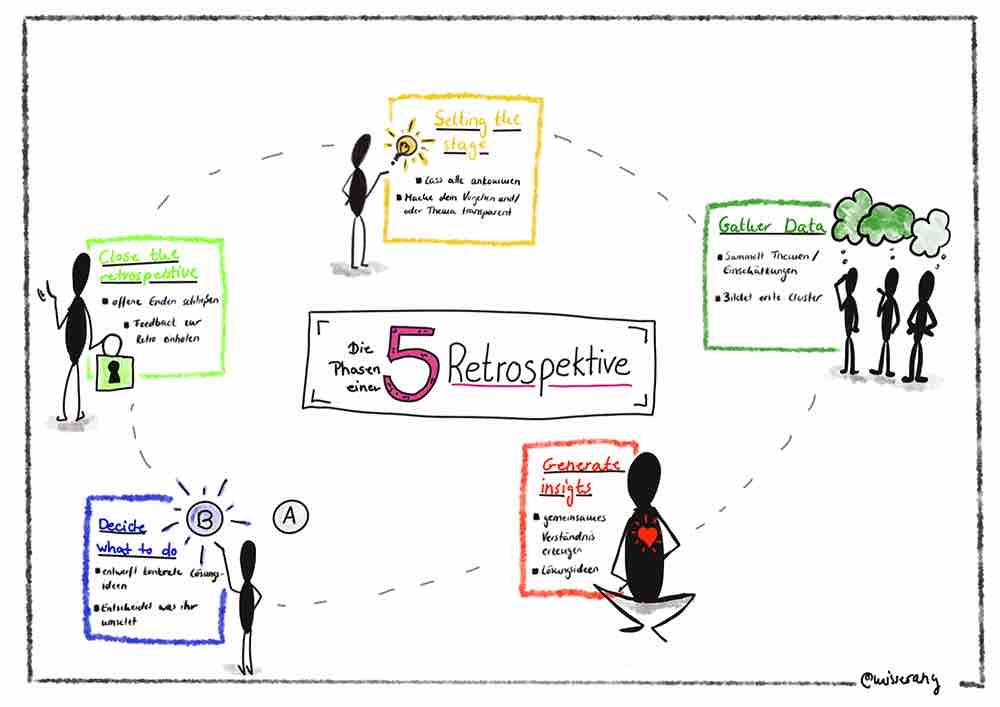
Daily Retro: Setting the stage
How do I usually start a retro myself?
First, I welcome all participants and introduce the topic of the retro. I always like to emphasize that our goal is to improve our Daily Scrum.
In thematic retrospectives, I always like to refer back to the theory behind the topic. It is important to me that the participants reflect once again on the theory behind Scrum, i.e. that they visualize once again how Scrum is actually conceived. This abstraction makes it easier for them to mentally detach themselves from their "work routine". For the theory, I pick up the Scrum Guide at this point and have all participants read through the section on the Daily Scrum again. I then ask briefly whether there are any questions regarding understanding.
Gather Data - Collects data on the Daily Scrum
In the next step, we need an assessment of the Daily Scrums by the team of this retrospective, i.e. by the participants.
To be able to collect this information in as structured and comprehensive a way as possible, I create a list of statements, as the Scrum Guide to Daily Scrums does.
I then ask the participants to assess how they perceive their Daily Scrum in relation to the following statements. Each participant assesses these statements for themselves based on two questions.
I would like to list the following statements:
- Our Daily Scrum always takes place at the same time and in the same place.
- The right people are invited and take part.
- Every Daily Scrum participant is prepared.
- We have a meaningful exchange in 15 minutes.
- Our Daily Scrum has an appropriate structure.
- The structure of the Daily Scrum is determined by the developers themselves.
- We create an action plan for the day in the Daily Scrum.
- We check our progress towards the sprint goal in the Daily Scrum.
The questions I ask the participants about the above statements are as follows:
1) How do you think we manage this point in the Scrum team?
2) Do you think we should change anything at this point?
Of course, you can also select other statements. For example, you can use the Daily Scrum Checklist or work out your own statements. It is important that there are not too many statements. In my experience, between 5-10 statements are sufficient.
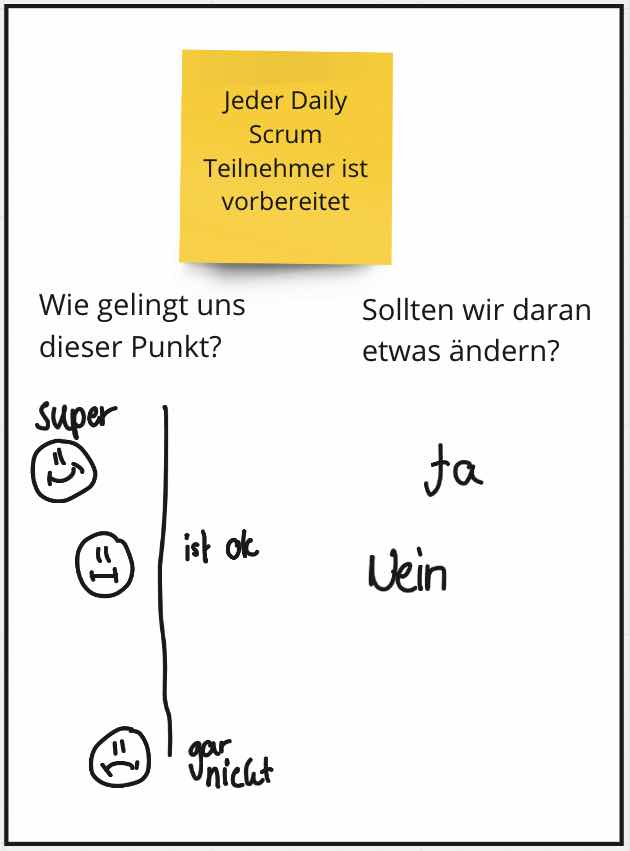
The assessment gives you an overview of how the participants themselves perceive their Daily Scrum. This is important because the team's assessment may well differ from your perception as Scrum Master.
With the feedback on the second question, you can also recognize which topics the participants really want to work on. This allows you to work on improvements together with the participants and at their pace.
Generate Insights - Understand your Daily Scrum
You can then evaluate the assessments together. I usually form pairs for this, as it's quicker to work in pairs and at the same time promotes exchange. When evaluating, you add up the total for each assessment. Here is an example:
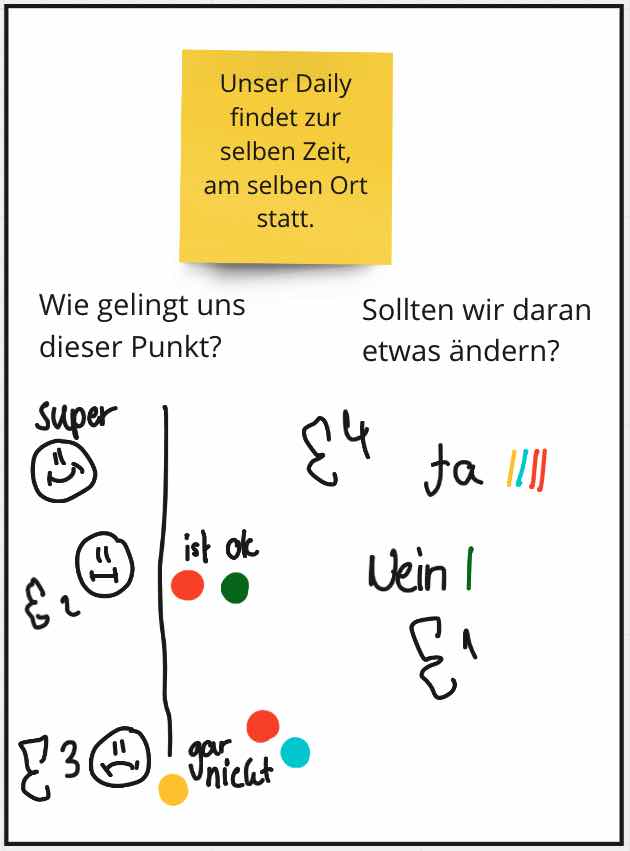
Then sort out what you want to look at first. The indicator for this is a high assessment value for both questions. The aim now is to understand this topic in more detail together. No solution ideas should be developed at this point! If you already jump into solution mode here, you could overlook important details and mistakenly treat symptoms instead of causes.
Let's stick with our example: "Our Daily Scrum always takes place at the same time and in the same place." At this point, ask yourselves the question: "What exactly is not working?" Everyone writes down one thing per post-it that is not working. Then everyone presents their post-its. I like to do this so that everyone reads out exactly what they have written down. If the topic has already been mentioned, it can be stuck on. On the one hand, this ensures that topics are not explained at length and, on the other, that you can form clusters while collecting them.
Based on the clusters, you now work out ideas for solutions. I like to do this in pairs, who choose a cluster and then formulate a solution idea for it. Another option is to have everyone write down ideas for solutions to the clusters for which they can think of some. You then present these solution ideas again. But make sure that questions of understanding are clarified and that the solution ideas are concrete!
Decide what to do - Just decide and get started
Solution ideas or ideas in general are great, there's just one problem: we almost always have too many of them. It is therefore important at this point that you choose where to start.
As a Scrum Master, it is important to pay particular attention to the following:
- The participants are the ones who make the choice.
No matter what the participants choose, it is the right thing for them at that moment. As Scrum Masters or Agile Coaches, we often see other solution ideas that could be helpful. However, in order to promote self-management and go at the pace of the team, it is important to respect the participants' decisions. - Only select an appropriate number of solution ideas.
Do not try to implement everything at once, but select an appropriate number of solution ideas. You can take up the ideas that are not currently being considered at a later date. The number of ideas to be selected depends on their complexity. For example, if you have many small and simple solution ideas, a few more can be advanced. If, on the other hand, you have chosen a larger and more complex solution idea, one may be sufficient at first.
Each participant now receives a number of votes that is determined in advance. For example, between 1-3 votes, which are made visible by points or similar during voting.
Now all participants can cast their votes. To avoid participants waiting and to force a decision, I set a timebox for this. For example, this is 3 minutes for 10 solution ideas.
You then evaluate the votes together. Now discuss again in detail how many of your solution ideas you want to implement. The top 3? Only the highest rated? It is important to make sure that you have agreed on how the solution idea will be implemented, when, where and by whom. Once these points have been defined, you can move on to the next phase of the retrospective.
Close the Retrospective - Finding a good conclusion
Following the selection of your measure, the retrospective will now be completed. The goals are:
- To give a brief summary of the retro
- Get feedback on the Retro approach
First of all, I would like to take this opportunity to thank the participants for their time and cooperation. This appreciation of the participants is very important to me. I then briefly summarize verbally which topics we have worked on and what we have now agreed. Before I move on to the second objective, I ask if anyone else would like to add anything or add anything else. Only then do I move on to the second objective, the feedback on the procedure.
To get feedback on the procedure, you can ask one of the following questions, for example:
- How are you feeling right now?
- Do you believe in the solution we have worked out?
- How did you like this retrospective?
- Do you have any wishes for the next retrospective?
- Are you satisfied with our outcome?
- Is there anything else that needs to be said?
You can discuss these questions verbally or answer them in writing when you leave the room. I will decide on one of the two options at short notice based on the energy in the room and the time.

If there is still energy in the room and time, a short "flashlight" can be an option. During the flash, each participant either says a sentence or has a short timebox, e.g. 1 minute. However, if energy is low or time is short or both, then I prefer written feedback on the way out. I have prepared a presentation for this and the participants can place themselves there and/or leave comments.
Follow-up retrospective - tips for the Scrum Master
The retrospective is now over for the participants. As a Scrum Master, I would like to leave you with a few thoughts.
- Document the retrospective
Use the time directly after the retrospective to document it. Why? So that you can remember what you have worked on and your observations later. This way, you can continue to work with it and not forget half of it in everyday life. The documentation is done with a tool and in a scope of your choice. I usually use my Scrum Master Journal for this and note down not only the results, but also my observations. I also like to use screenshots and photos of the results.
In addition, such documentation is also useful if not all invited participants were present. In this case, make sure that you tell the participants during the retrospective to share the results of the retrospective with team members who are not present. - What tasks are there for you?
Are there any tasks for you in retrospect? I usually try to implement these immediately so that I can then complete the topic. Even if sometimes it's just setting deadlines.
Conclusion on the Daily Scrum Retrospective format
The Daily Scrum is the Scrum event that we use most frequently. It is our monitoring of whether we manage to achieve the sprint goal. It is therefore only logical for me to pay attention to building a meaningful and value-adding Daily Scrum. However, it is often deadlocked and not a real exchange, or worse still, a status report. With the application of the retrospective format I described, I was able to help Scrum teams use their Daily Scrum for themselves and feel comfortable with it. So I hope it can help too. If you have any questions or feedback, please feel free to leave a comment.
Your Anna Rudat

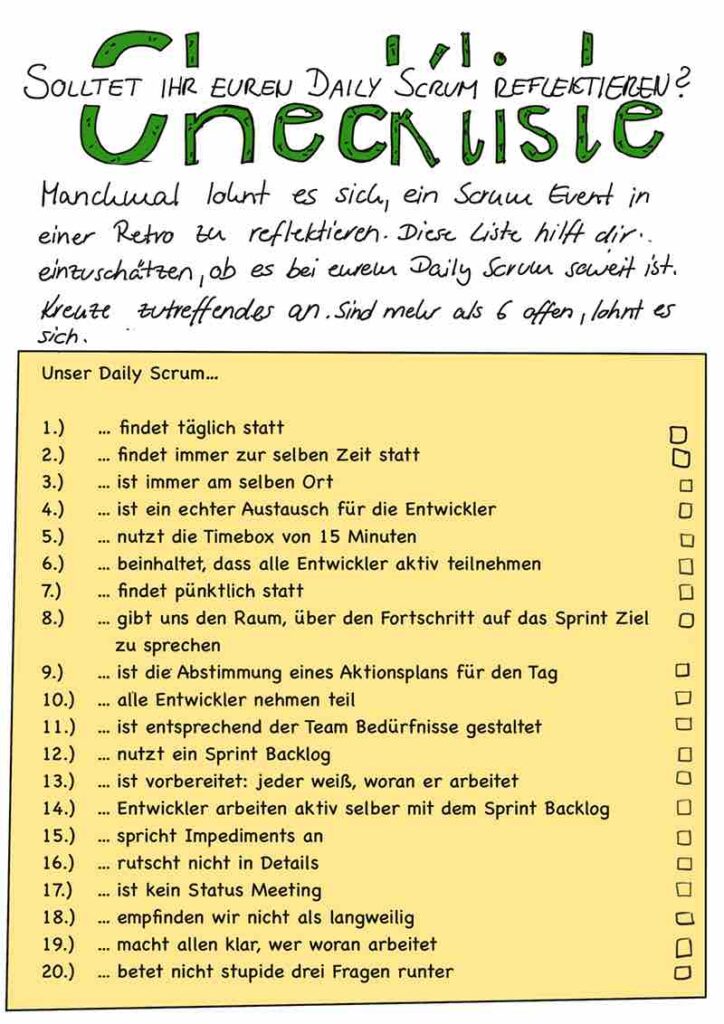
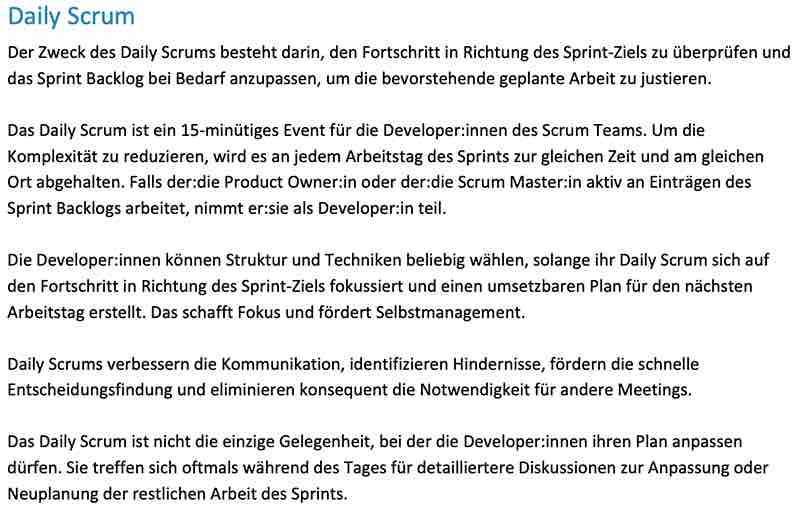
Write a comment